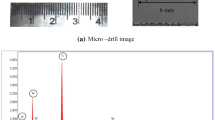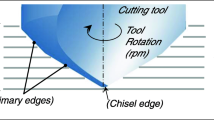Abstract
This paper focuses on artificial neural network (ANN)-based modeling of surface and hole quality in drilling of AISI D2 cold work tool steel with uncoated titanium nitride (TiN) and titanium aluminum nitride (TiAlN) monolayer- and TiAlN/TiN multilayer-coated-cemented carbide drills. A number of drilling experiments were conducted at all combinations of different cutting speeds (50, 55, 60, and 65 m/min) and feed rates (0.063 and 0.08 mm/rev) to obtain training and testing data. The experimental results showed that the surface roughness (Ra) and roundness error (Re) values were obtained with the TiN monolayer- and TiAlN/TiN multilayer-coated drills, respectively. Using some of the experimental data in training stage, an ANN model was developed. To evaluate the performance of the developed ANN model, ANN predictions were compared with the experimental results. It was found that the determination coefficient values are more than 0.99 for both training and test data. Root mean square error and mean error percentage values were very low. ANN results showed that ANN can be used as an effective modeling technique in accurate prediction of the Ra and Re.
Similar content being viewed by others
References
Coldwell HL, Dewes RC, Aspinwall DK, Renevier NM, Teer DG (2004) The use of soft/lubricating coatings when dry drilling BS L168 aluminium alloy. Surf Coat Technol 177–178:716–726
Grzesik W (2000) An integrated approach to evaluating the tribo-contact for coated cutting inserts. Wear 240:9–18
Braic V, Zotia CN, Balaceanu M, Kiss A, Vladescu A, Popescu A, Braic M (2010) TiAlN/TiAlZrN multilayered hard coatings for enhanced performance of HSS drilling tools. Surf Coat Technol 204:1925–1928
Lee DK, Lee SH, Lee JJ (2003) The structure and mechanical properties of multilayer TiN/(Ti0.5Al0.5)N coatings deposited by plasma enhanced chemical vapor deposition. Surf Coat Technol 169–170:433–437
Kurt M, Kaynak Y, Bagci E (2008) Evaluation of drilled hole quality in Al 2024 alloy. Int J Adv Manuf Technol 37:1051–1060
Kalidas S, DeVor RE, Kapoor SG (2001) Experimental investigation of the effect of drill coatings on hole quality under dry and wet drilling conditions. Surf Coat Technol 148:117–128
Xue C, Chen WY (2012) The performances of different coated carbide drills when drilling a cast nickel-based alloy. Adv Mater Res 497:41–45
Harris SG, Doyle ED, Vlasveld AC, Dolder PJ (2001) Dry cutting performance of partially filtered arc deposited titanium aluminium nitride coatings with various metal nitride base coatings. Surf Coat Technol 146–147:305–311
Sharif S, Rahim EA (2007) Performance of coated- and uncoated-carbide tools when drilling titanium alloy—Ti–6Al4V. J Mater Process Technol 185:72–76
Adel MH, Alrashdan A, Hayajneh MT, Mayyas AT (2009) Prediction of density, porosity and hardness in aluminum–copper-based composite materials using artificial neural network. J Mater Process Technol 209:894–899
Gaitonde VN, Karnik SR, Figueira L, Davim JP (2011) Performance comparison of conventional and wiper ceramic inserts in hard turning through artificial neural network modeling. Int J Adv Manuf Technol 52:101–114
Hayajneh M, Adel MH, Alrashdan A, Mayyas AT (2009) Prediction of tribological behavior of aluminum–copper based composite using artificial neural network. J Alloy Compd 470:584–588
Yu J (2011) Online tool wear prediction in drilling operations using selective artificial neural network ensemble model. Neural Comput Appl 20:473–485
Chavoshi SZ (2011) Analysis and predictive modeling of performance parameters in electrochemical drilling process. Int J Adv Manuf Technol 53:1081–1101
Sanjay C, Jyothi C (2006) A study of surface roughness in drilling using mathematical analysis and neural networks. Int J Adv Manuf Technol 29:846–852
Vrabel M, Mankova I, Beno J, Tuharský J (2012) Surface roughness prediction using artificial neural networks when drilling Udimet 720. Procedia Eng 48:693–700
Bustillo A, Correa M (2012) Using artificial intelligence to predict surface roughness in deep drilling of steel components. J Intell Manuf 23:1893–1902
Grzenda M, Bustillo A, Zawistowski P (2012) A soft computing system using intelligent imputation strategies for roughness prediction in deep drilling. J Intell Manuf 23:1733–1743
Tsao CC, Hocheng H (2008) Evaluation of thrust force and surface roughness in drilling composite material using Taguchi analysis and neural network. J Mater Process Technol 203:342–348
Çiçek A, Kıvak T, Uygur I, Ekici E, Turgut Y (2012) Performance of cryogenically treated M35 HSS drills in drilling of austenitic stainless steels. Int J Adv Manuf Technol 60:65–73
Kıvak T, Samtaş G, Çiçek A (2012) Taguchi method based optimization of drilling parameters in drilling of AISI 316 steel with PVD monolayer and multilayer coated HSS drills. Meas 45:1547–1557
Çay Y, Korkmaz I, Çiçek A, Kara F (2013) Prediction of engine performance and exhaust emissions for gasoline and methanol using artificial neural network. Energy. doi:10.1016/j.energy.2012.10.052
Çay Y, Çiçek A, Kara F, Sağiroğlu S (2012) Prediction of engine performance for an alternative fuel using artificial neural network. Appl Therm Eng 37:217–225
Ciftci I (2006) Machining of austenitic stainless steels using CVD multi-layer coated cemented carbide tools. Tribol Int 39:565–569
Kim D, Ramulu M (2004) Drilling process optimization for graphite/bismaleimide–titanium alloy stacks. Compos Struct 63:101–114
Author information
Authors and Affiliations
Corresponding author
Rights and permissions
About this article
Cite this article
Akıncıoğlu, S., Mendi, F., Çiçek, A. et al. ANN-based prediction of surface and hole quality in drilling of AISI D2 cold work tool steel. Int J Adv Manuf Technol 68, 197–207 (2013). https://doi.org/10.1007/s00170-012-4719-6
Received:
Accepted:
Published:
Issue Date:
DOI: https://doi.org/10.1007/s00170-012-4719-6




